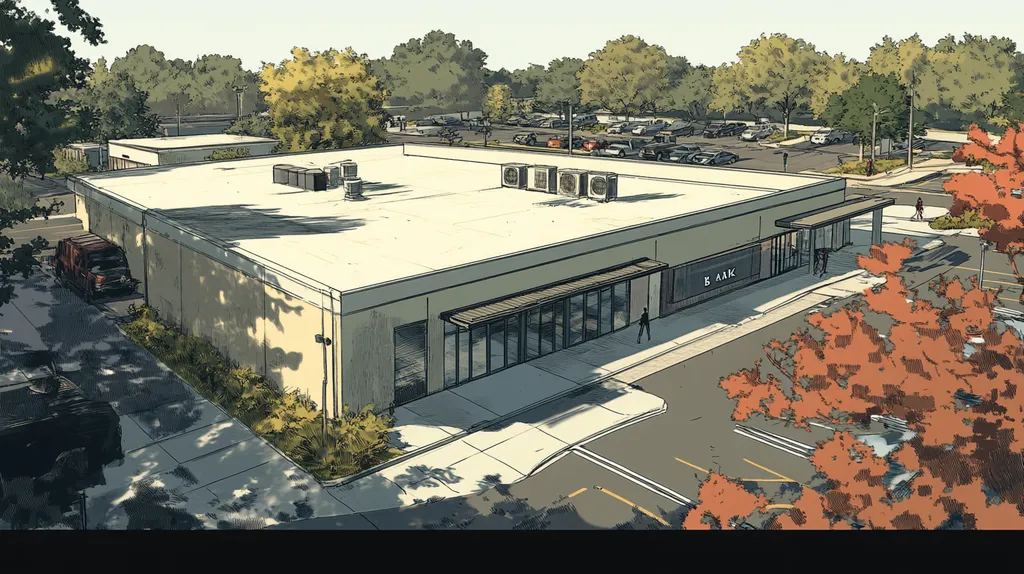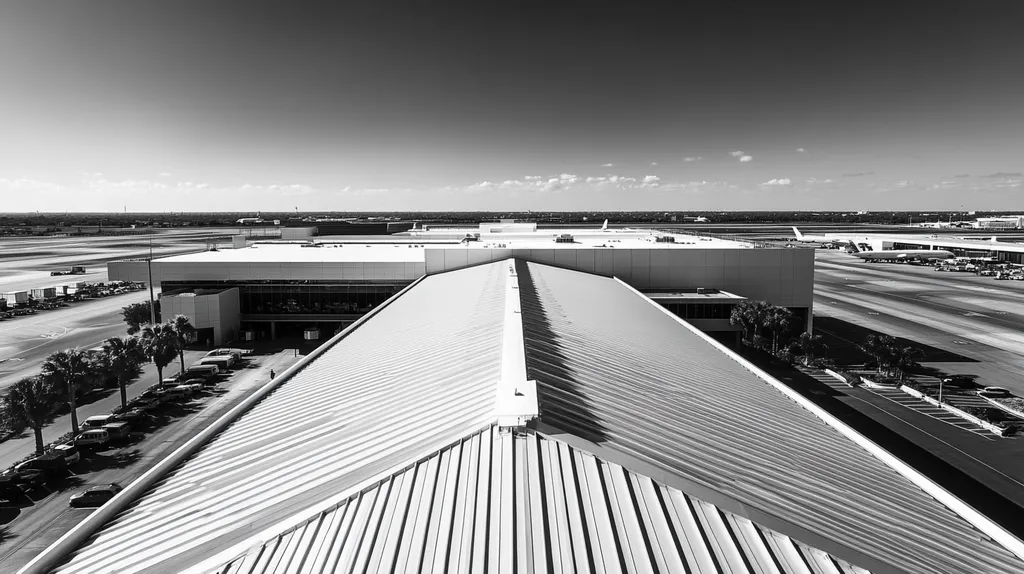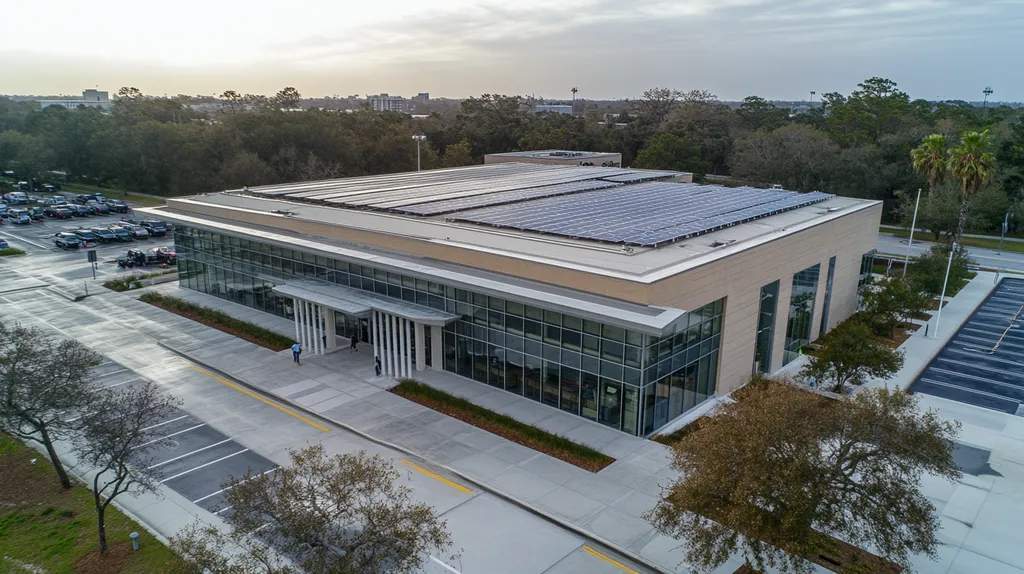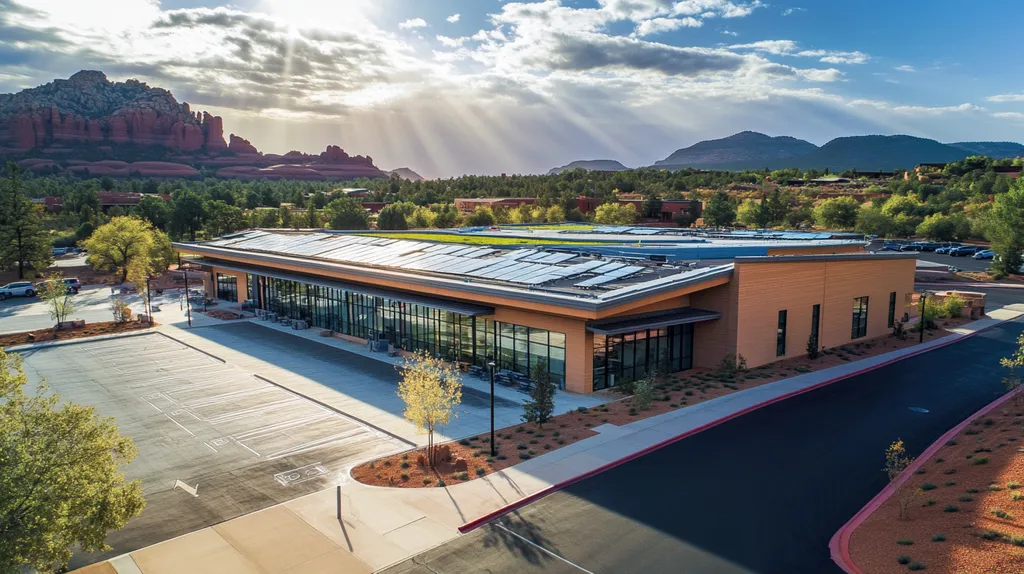Commercial roofs face a silent killer that costs facility managers millions in premature replacements. UV radiation destroys roofing materials from day one, cutting expected lifespans by 30% or more while driving up energy costs through reduced reflectivity.
Most properties operate without adequate UV protection, transforming 20-year roof investments into 14-year liabilities. The financial impact compounds as damaged membranes lose waterproofing capabilities and thermal efficiency.
This guide cuts through industry complexity to reveal proven UV protection strategies. Facility managers will discover practical applications, cost considerations, and warning signs that prevent emergency replacement scenarios while maximizing roof performance.
SECTION 1: THE BASICS EXPLAINED
Every day, your commercial roof absorbs invisible punishment that slowly destroys its protective capabilities. Ultraviolet radiation silently breaks down materials worth hundreds of thousands of dollars, yet most facility managers only discover this damage after leaks appear.
The financial impact is staggering—UV exposure can cut roof lifespan by 30% or more, transforming a 20-year investment into a 14-year liability. Understanding how UV protection works isn’t just technical knowledge; it’s essential armor against premature roof failure and emergency replacement costs.
What It Is (In Plain Language)
UV protection for commercial roofs works like industrial-strength sunscreen for your building. These systems use specialized coatings, membranes, and treatments to block or reflect the sun’s damaging ultraviolet rays before they penetrate roofing materials.
Without this protection, UV rays break down the chemical bonds in roofing materials, leading to degradation that affects everything from flexibility to waterproofing. The invisible energy literally tears apart the molecular structure that keeps your roof intact.
Think of it as a shield that sits between your expensive roofing system and the sun’s constant assault. This barrier prevents the slow-motion destruction that turns robust materials into brittle, cracked surfaces over time.
The protection comes in various forms—reflective coatings that bounce rays away, specialized membranes with built-in UV stabilizers, and surface treatments that absorb harmful energy safely. Each method serves the same critical purpose: preserving your roof’s structural integrity against invisible threats.
Why It Matters (To Your Building)
UV damage creates a cascade of problems that facility managers face year after year. Prolonged UV exposure causes color fading, reduces insulating properties, and increases vulnerability to water damage, turning minor maintenance into major headaches.
The thermal stress alone can destroy a roof system. As UV rays heat the surface, materials expand during the day and contract at night, creating fatigue cycles that crack membranes and separate seams.
Energy costs climb when UV-damaged roofs lose their reflective properties and insulation efficiency. Your HVAC system works harder to compensate for the increased heat gain, driving up operational expenses month after month.
Water infiltration becomes inevitable as UV-weakened materials develop brittleness and lose their ability to seal properly. What started as invisible molecular damage transforms into visible leaks, interior damage, and business disruption.
The bottom line is simple: UV protection directly correlates with roof lifespan and building integrity (source: Greatway Roofing). Facilities that ignore this reality face shortened asset life and unpredictable replacement schedules.
How It Works
UV protective systems operate through two primary mechanisms: reflection and absorption. Reflective coatings contain specialized pigments that bounce ultraviolet rays back into the atmosphere, preventing them from reaching the roof membrane.
Absorption-based protection captures UV energy and dissipates it as harmless heat, neutralizing the rays before they can break down roofing materials. Advanced membranes incorporate UV stabilizers directly into their composition, providing built-in protection.
The most effective systems combine both approaches, creating multiple layers of defense. This redundancy ensures that if one protective element degrades over time, others continue safeguarding the roof structure.
Temperature control plays a crucial role in the protection process. By reducing surface temperatures through reflection, UV protection minimizes thermal expansion and contraction cycles that stress roofing materials.
The result is preserved material flexibility, maintained waterproofing capabilities, and delayed weathering effects. This comprehensive protection extends functional lifespan and reduces the strain that leads to premature roof failure.
SECTION 2: PRACTICAL APPLICATIONS
UV protection isn’t theoretical—it’s actively saving millions of dollars across commercial properties right now. Facility managers who implement proven UV shielding strategies report roof lifespans extending 40-60% beyond unprotected systems.
The difference between protected and unprotected roofs becomes stark within five years of installation. While some properties enjoy decades of reliable performance, others face emergency repairs and premature replacement costs that devastate maintenance budgets.
Common Uses & Examples
Manufacturing facilities with large flat roofs rely heavily on elastomeric coatings that reflect up to 90% of UV radiation. These white or light-colored coatings transform heat-absorbing surfaces into reflective barriers that maintain structural integrity for decades.
Retail centers and shopping malls frequently use TPO and PVC membranes with integrated UV stabilizers. These single-ply systems combine waterproofing with built-in protection, eliminating the need for separate coating applications while maintaining flexibility in extreme temperatures.
Warehouse operations often retrofit existing roofs with acrylic or silicone coatings when replacement isn’t feasible. This approach extends service life by 10-15 years while improving energy efficiency through enhanced reflectivity.
Metal roofing on industrial buildings incorporates specialized paint systems containing UV inhibitors that prevent chalking and color degradation. UV rays can cause degradation of roofing materials by breaking down chemical bonds, leading to brittleness and cracking, along with color fading, loss of insulation properties, and increased vulnerability to water damage (source: Great Way Roofing).
Hospital and healthcare facilities prioritize seamless membrane systems with maximum UV resistance to ensure uninterrupted operations. These mission-critical applications demand the highest level of protection against material failure.
When You Need It Most
New roof installations require immediate UV protection to prevent degradation from the first day of service. Exposed membranes begin deteriorating within weeks of installation, making protective coatings essential during the construction phase.
Summer months present the highest risk for UV damage when sun angles and intensity reach their peak. Surface temperatures can exceed 180°F on unprotected roofs, accelerating chemical breakdown and thermal stress cycles.
High-altitude locations and sun-belt regions experience intensified UV exposure that demands premium protection systems. Denver’s mile-high elevation increases UV intensity by 25% compared to sea-level installations.
Roof repairs create vulnerable exposure points where fresh materials need immediate shielding. Temporary UV barriers prevent accelerated aging during extended repair projects that might take weeks to complete.
Building expansions and equipment installations often compromise existing UV protection, requiring immediate restoration to prevent localized damage that spreads across the entire roof system.
Interactions With Other Systems
HVAC equipment benefits significantly from UV-protected roofs that maintain lower surface temperatures throughout the day. Reduced heat island effects improve air conditioning efficiency and extend equipment lifespan by minimizing thermal stress.
Insulation systems perform better when UV protection prevents membrane degradation that could allow moisture infiltration. Wet insulation loses 40% of its thermal resistance, driving up energy costs while promoting mold growth.
Drainage systems must accommodate UV coatings that might alter surface texture or create slight thickness variations. Proper coordination ensures water flows effectively without creating ponding areas that accelerate membrane failure.
Solar panel installations create shaded areas that experience different thermal cycling than exposed sections. UV protection must account for these temperature variations to prevent differential movement and membrane stress.
Fire suppression systems and rooftop equipment require UV-compatible materials that won’t degrade under chemical exposure or extreme heat conditions during emergency operations.
SECTION 3: KEY TERMINOLOGY DECODED
Facility managers waste thousands of dollars annually because they don’t understand UV protection terminology. Contractors exploit this knowledge gap, selling inferior materials or unnecessary treatments while genuine protection needs go unaddressed.
The roofing industry uses complex jargon that obscures critical differences between materials and their protective capabilities. Without clarity on essential terms, property owners make decisions based on price alone, sacrificing long-term durability for short-term savings.
Essential Terms Explained
UV degradation describes the invisible molecular breakdown that destroys roofing materials over time. UV rays break down the chemical bonds in roofing materials, leading to degradation that causes color fading, loss of insulation properties, and increased vulnerability to water damage (source: Greatway Roofing).
Solar reflectance measures how much sunlight a roof surface bounces back into the atmosphere rather than absorbing as heat. Higher reflectance values mean cooler roof temperatures and reduced UV stress on materials.
Thermal emittance indicates how efficiently a roof releases absorbed heat back to the sky during nighttime hours. This cooling process prevents heat buildup that accelerates chemical breakdown in roofing membranes.
Weatherability refers to a material’s ability to resist UV exposure, temperature cycles, and moisture without losing structural integrity. Premium materials maintain weatherability for decades, while inferior options fail within years.
UV stabilizers are chemical additives that absorb harmful ultraviolet energy and convert it to harmless heat. These molecular guardians prevent the chain reactions that cause material brittleness and cracking.
Industry Jargon Translated
Cool roofing technology combines high solar reflectance with high thermal emittance to minimize heat absorption and maximize heat release. This dual-action approach reduces surface temperatures by 50-80 degrees compared to conventional dark roofs.
Albedo represents the scientific measurement of surface reflectivity across the entire solar spectrum. Roofing professionals often use this term interchangeably with solar reflectance, though albedo encompasses broader wavelengths.
Photodegradation specifically describes UV-induced chemical reactions that break polymer chains in synthetic roofing materials. This process transforms flexible membranes into brittle surfaces prone to cracking and water infiltration.
Energy Star compliance indicates roofing products meet federal standards for solar reflectance and thermal emittance. These ratings provide reliable benchmarks for comparing UV protection capabilities across different manufacturers.
Service life acceleration occurs when UV exposure speeds up normal aging processes, causing materials to fail years before their expected lifespan. Understanding this concept helps predict replacement timing and budget requirements.
Measurement & Units Simplified
Solar reflectance values range from 0.0 to 1.0, with higher numbers indicating better UV protection. A roof with 0.8 reflectance bounces back 80% of solar energy, while 0.3 reflectance absorbs 70% as damaging heat.
Membrane thickness measured in mils directly affects UV resistance and durability. Standard commercial membranes range from 45-80 mils, with thicker options providing longer protection against UV penetration and mechanical damage.
UV exposure testing uses accelerated weathering chambers that simulate decades of sun damage in months. Results measured in kilolangleys help predict real-world performance under specific climate conditions.
Temperature differential measurements show the cooling benefits of UV protection systems. Protected roofs typically run 30-50 degrees cooler than unprotected surfaces, reducing thermal stress and extending material life.
Warranty coverage terms often correlate with UV protection quality, ranging from 10-30 years depending on material specifications. Longer warranties indicate manufacturer confidence in UV resistance capabilities and long-term performance.
SECTION 4: DECISION FACTORS
Smart UV protection decisions separate thriving facilities from those facing emergency roof replacements. Facility managers who choose based on price alone often discover their “savings” cost 300% more when premature failures strike.
The difference between excellent and mediocre UV protection becomes painfully clear within five years. While some properties enjoy decades of reliable performance, others battle recurring leaks, energy spikes, and budget overruns that could have been prevented.
Cost Considerations
Initial material costs tell only part of the UV protection story. Premium reflective coatings and UV-resistant membranes cost 20-40% more upfront but deliver energy savings that often recover the investment within three to five years.
Energy impact calculations reveal the true cost difference between protection levels. High-performance UV barriers can reduce cooling costs by 15-25% annually, while inferior protection allows heat gain that drives HVAC expenses through the roof.
Maintenance frequency changes dramatically based on UV protection quality. Facilities with basic protection face coating renewals every 5-7 years, while premium systems maintain effectiveness for 15-20 years with minimal intervention.
Replacement timing becomes predictable with proper UV shielding versus chaotic with inadequate protection. Emergency roof replacement costs 40-60% more than planned projects due to expedited scheduling, limited contractor availability, and weather delays.
Total cost of ownership calculations must include energy savings, maintenance reduction, and extended lifespan benefits. Facilities that evaluate only purchase price consistently make decisions that multiply long-term expenses while reducing asset performance.
Performance Trade-offs
Every UV protection method involves compromises that affect other roofing functions. Highly reflective white coatings maximize heat reflection but may show dirt more readily than darker alternatives, requiring more frequent cleaning in industrial environments.
Membrane thickness directly impacts both UV resistance and installation complexity. Thicker membranes provide superior protection but require specialized equipment and experienced crews, potentially limiting contractor options in some markets.
Chemical resistance varies significantly among UV protection systems. Facilities with rooftop equipment that might leak oils or solvents need protection that maintains UV effectiveness even after chemical exposure incidents.
Traffic tolerance becomes critical for roofs requiring regular maintenance access. Some premium UV coatings excel at solar reflection but develop wear patterns under foot traffic, while others maintain protection despite frequent walking.
Weather resistance spans beyond UV to include hail impact, wind uplift, and thermal cycling. Balanced protection systems address multiple threats without sacrificing UV performance, though specialized applications might prioritize specific hazards over others.
Lifespan & Durability Factors
UV protection quality directly determines whether roofs achieve their designed service life or fail prematurely. Superior protection systems routinely extend roof lifespan from 15 years to 25-30 years, while inadequate shielding can cause failure within 8-12 years.
Climate intensity affects protection requirements and expected durability. Desert installations with extreme UV exposure need premium materials that might be unnecessary in northern climates, though even moderate UV levels cause significant damage over time.
Installation quality influences protection effectiveness regardless of material specifications. Properly applied basic protection often outperforms premium materials with installation defects, making contractor selection as important as product choice.
Warranty coverage reflects manufacturer confidence in UV protection durability. Materials with 20-30 year warranties typically contain superior UV stabilizers and proven track records, while shorter warranties signal potential performance limitations.
Maintenance requirements determine whether protection systems maintain effectiveness throughout their intended lifespan. Low-maintenance options reduce long-term costs and eliminate the risk of neglected upkeep that compromises UV shielding over time.
SECTION 5: COMMON CHALLENGES
UV-related roof failures catch facility managers off guard year after year, despite following standard maintenance schedules. The invisible nature of UV damage creates a false sense of security—roofs appear functional until catastrophic failure strikes without warning.
Industry data reveals that 70% of premature commercial roof replacements stem from unaddressed UV degradation issues. These problems compound rapidly once they begin, transforming minor maintenance concerns into emergency replacement scenarios that devastate facility budgets.
Frequent Problems & Solutions
Membrane brittleness ranks as the most destructive UV-related problem facing commercial roofs today. Extended UV exposure breaks down polymer chains, transforming flexible waterproof barriers into rigid surfaces that crack under normal building movement.
Coating failure creates another persistent challenge as protective layers lose adhesion and peel away in sheets. This exposes underlying membranes to direct UV assault, accelerating degradation that spreads across entire roof sections within months.
Thermal cycling damage occurs when UV-heated surfaces expand and contract daily, creating stress fractures at seams and penetrations. These microscopic cracks grow larger each season until water infiltration becomes inevitable.
The most effective solution combines immediate surface protection with long-term material upgrades. Elastomeric coatings restore UV shielding while membrane reinforcement prevents future thermal stress damage.
Professional UV assessment identifies vulnerable areas before visible damage appears. This proactive approach allows targeted repairs that cost 60% less than emergency replacement projects.
Warning Signs To Watch For
Surface chalking appears as a powdery residue that rubs off when touched, indicating advanced UV breakdown of coating materials. This warning sign typically appears 2-3 years before membrane failure becomes critical.
Color fading and discoloration signal the loss of UV-protective pigments that maintain material integrity. Dark streaks or blotchy patches often mark areas where protection has completely failed.
Membrane shrinkage creates visible gaps at flashings and seams as UV-damaged materials lose flexibility and contract. These openings allow water penetration that accelerates structural damage throughout the building.
Energy cost increases frequently indicate lost reflectivity as UV damage reduces the roof’s ability to deflect solar heat. A 60-mil roof lasting 22 to 27 years can vary mainly due to UV exposure level, with more intense UV exposure creating shorter roof lifespans (source: Mid-South Roof Systems).
Interior temperature fluctuations and HVAC strain suggest compromised thermal barriers that allow heat transfer through UV-degraded roofing systems.
Preventative Approaches
Immediate post-installation protection prevents UV damage from starting during the vulnerable early months. Applying protective coatings within 30 days of membrane installation eliminates the window when fresh materials begin degrading.
Scheduled coating renewal every 5-7 years maintains continuous UV shielding regardless of environmental conditions. This systematic approach costs 40% less than reactive repairs and eliminates surprise failures.
Strategic material selection during roof replacement prioritizes UV-resistant options like TPO and PVC membranes with built-in stabilizers. These premium materials resist degradation for decades without additional protective treatments.
Regular professional inspections identify UV damage during the repairable stage before emergency intervention becomes necessary. Semi-annual assessments catch problems when simple coating applications can restore full protection.
Documentation of UV protection measures helps predict replacement timing and budget requirements years in advance. This planning approach eliminates emergency scenarios while maximizing equipment service life.
SECTION 6: NEXT STEPS & RESOURCES
Facility managers lose millions annually because they ask the wrong questions when selecting UV protection systems. Without proper guidance, they accept vague promises instead of demanding specific performance data, warranty coverage, and maintenance protocols that determine long-term success.
The gap between industry standards and actual practice creates costly vulnerabilities that destroy budgets and careers. Properties following established guidelines enjoy predictable performance and extended roof life, while those operating without clear frameworks face recurring failures and emergency replacements.
Questions To Ask Providers
Demand specific solar reflectance and thermal emittance values for any UV protection system under consideration. Contractors who cannot provide CRRC-rated performance data lack the technical foundation necessary for reliable protection recommendations.
Request detailed warranty coverage that explicitly addresses UV-related degradation, not just manufacturing defects. Many warranties exclude UV damage through fine print loopholes, leaving facilities exposed to the very problems protection systems should prevent.
Ask for local performance references from facilities with similar UV exposure conditions and operational requirements. Generic testimonials mean nothing compared to documented results from comparable installations in your specific climate zone.
Inquire about maintenance requirements and costs throughout the protection system’s expected lifespan. Hidden maintenance expenses often exceed initial material savings, transforming apparent bargains into long-term financial disasters.
Verify installation crew certification and experience with your specific protection system. Even premium materials fail when applied by inexperienced contractors who lack proper training and quality control procedures.
Industry Standards & Guidelines
Industry standards such as the Cool Roof Rating Council (CRRC) and the National Roofing Contractors Association (NRCA) provide guidelines on UV protection and roofing material lifespans. These frameworks eliminate guesswork by establishing measurable criteria for reflectance, emittance, and durability performance.
ASTM International testing protocols ensure UV protection claims reflect real-world performance under accelerated weathering conditions. Materials meeting ASTM standards undergo rigorous evaluation that predicts long-term effectiveness better than marketing promises.
Energy Star certification requirements set minimum performance thresholds that deliver measurable cooling benefits and energy savings. Facilities using Energy Star-rated materials consistently achieve lower operating costs and extended equipment life.
Cool Roof Rating Council databases provide independent verification of manufacturer claims through third-party testing. This transparency allows facility managers to compare products objectively without relying on sales presentations alone.
NRCA installation guidelines prevent common application errors that compromise UV protection effectiveness regardless of material quality. Following these standards ensures protection systems perform as designed throughout their intended service life.
Further Learning Simplified
Professional development through NRCA educational programs keeps facility managers current on UV protection innovations and best practices. These resources translate complex research into actionable strategies that prevent costly mistakes during material selection and implementation.
Manufacturer technical bulletins provide detailed application guidance and troubleshooting procedures specific to individual UV protection systems. This documentation becomes invaluable when addressing performance issues or planning maintenance schedules.
Trade publications like Professional Roofing Magazine offer case studies demonstrating successful UV protection strategies across different building types and climate conditions. Real-world examples provide practical insights that theoretical knowledge cannot match.
Regional roofing associations deliver localized expertise addressing specific UV challenges in your geographic area. Climate-specific guidance prevents over-engineering in mild conditions or under-specification in extreme UV environments.
Online certification courses enable continuous learning without travel expenses or schedule disruption. These programs cover emerging technologies and evolving standards that keep facilities ahead of industry developments rather than reacting to problems after they occur.
The Bottom Line
Commercial roofs without proper UV protection fail 30% sooner than protected systems, transforming 20-year investments into 14-year disasters that devastate facility budgets.
The evidence is overwhelming—UV radiation silently destroys millions of dollars in roofing assets while facility managers focus on visible problems.
Facilities implementing comprehensive UV protection strategies report extended lifespans, reduced energy costs, and predictable maintenance schedules that eliminate emergency replacements.
The choice is stark: invest in proven UV protection now or face premature roof failure within a decade.
Every month of delay accelerates invisible damage that compounds into catastrophic membrane failure and emergency replacement costs.
Smart facility managers act immediately, implementing UV protection systems before degradation begins and budget disasters strike.
FREQUENTLY ASKED QUESTIONS
Q. What is UV protection and why does my commercial roof need it?
A. UV protection acts like a sunscreen barrier that shields your roof from harmful ultraviolet rays. Without it, the sun’s invisible radiation breaks down roof materials at the molecular level, causing brittleness and leaks long before the roof’s expected lifespan ends. Proper shielding prevents costly premature failures and extends your roof’s durability.
Q. How is UV protection applied to industrial roofs in real-world settings?
A. UV protection is integrated through coatings, membranes, or surface treatments tailored to roof types and climate conditions. Common methods include reflective elastomeric coatings on flat roofs, TPO or PVC membranes with built-in UV stabilizers, and specialty paints for metal roofing. These applications prevent rapid degradation and can extend roof life by decades when maintained properly.
Q. What key UV protection terms should commercial roof managers understand?
A. Understanding terms like solar reflectance, thermal emittance, weatherability, and UV stabilizers is crucial for informed decisions. These describe how well a roof reflects sunlight, releases heat, withstands weather stresses, and chemically blocks UV damage. Clear knowledge helps avoid subpar products sold under confusing jargon.
Q. What factors should influence my commercial roof UV protection decision?
A. Beyond upfront cost, consider long-term energy savings, maintenance frequency, and expected lifespan improvements. High-quality protection systems might cost more initially but reduce HVAC expenses and delay replacements. Also evaluate chemical resistance, traffic tolerance, and warranty terms to balance performance with your facility’s unique needs.
Q. What common UV-related issues cause commercial roof failures?
A. Membrane brittleness, coating peeling, and thermal cycling fractures are frequent culprits. UV exposure breaks down materials causing cracks and loss of waterproofing, which leads to leaks and costly emergency repairs. Early detection and timely coating renewals can prevent these problems and extend roof service life significantly.
Q. What questions should I ask providers about commercial roof UV protection?
A. Request detailed solar reflectance and thermal emittance ratings, ask about specific UV damage warranties, and seek references from similar climates. Also confirm maintenance plans and verify installer certifications. Knowing these facts ensures you invest in proven protection rather than vague promises.
Q. How does UV protection impact energy efficiency of industrial roofs?
A. UV protection reflects harmful rays and reduces roof surface temperatures, which lowers heat gain inside the building. This decreases the workload on cooling systems, cutting energy consumption and operational costs. Effective shielding keeps insulation effective and prevents thermal stress, contributing to a more stable and efficient facility environment.









